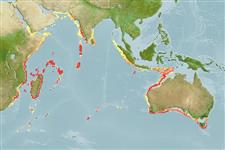Classification / Names
Nomi Comuni | Sinonimi | Catalog of Fishes(Genere, Specie) | ITIS | CoL | WoRMS | Cloffa
>
Acropomatiformes (Oceanic basses) >
Epigonidae (Deepwater cardinalfishes)
Eponymy: As Giles Mead did not include an etymology (in contrast to the other genus named in the same paper) we must assume the omission was deliberate. [...] (Ref. 128868), visit book page.
Environment: milieu / climate zone / depth range / distribution range
Ecologia
marino batidemersale; distribuzione batimetrica 150 - 800 m (Ref. 4329). Deep-water
Indian Ocean: in tropical and subtropical waters. One record from 32°11'S, 59°30'E.
Size / Peso / Age
Maturity: Lm ? range ? - ? cm
Max length : 10.0 cm TL maschio/sesso non determinato; (Ref. 4329)
Short description
Chiavi di identificazione | Morfologia | Morfometria
Spine dorsali (totale) : 8; Raggi dorsali molli (totale) : 8; Spine anali: 2; Raggi anali molli: 8. Specimens in alcohol light brown in color, fins darker; scale margins with black outline (Ref. 4329).
Life cycle and mating behavior
Maturità | Riproduzione | Deposizione | Uova | Fecundity | Larve
Gon, O., 1986. Apogonidae. p. 546-561. In M.M. Smith and P.C. Heemstra (eds.) Smiths' sea fishes. Springer-Verlag, Berlin. (Ref. 4329)
IUCN Red List Status (Ref. 130435: Version 2024-1)
Threat to humans
Harmless
Human uses
Strumenti
Special reports
Download XML
Fonti Internet
Estimates based on models
Preferred temperature (Ref.
123201): 9.2 - 15.3, mean 11.8 °C (based on 89 cells).
Phylogenetic diversity index (Ref.
82804): PD
50 = 1.0000 [Uniqueness, from 0.5 = low to 2.0 = high].
Bayesian length-weight: a=0.00646 (0.00275 - 0.01515), b=3.10 (2.89 - 3.31), in cm total length, based on LWR estimates for this (Sub)family-body shape (Ref.
93245).
Trophic level (Ref.
69278): 3.3 ±0.5 se; based on size and trophs of closest relatives
Resilienza (Ref.
120179): Alto, tempo minimo di raddoppiamento della popolazione meno di 15 mesi (Preliminary K or Fecundity.).
Fishing Vulnerability (Ref.
59153): Low vulnerability (10 of 100).
